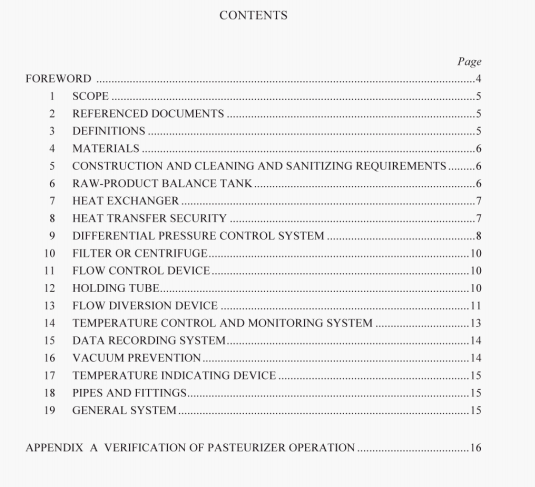AS 3993:2003 pdf – Equipment for the pasteurization of milk and other liquid dairy products- Continuous-flow systems.
(d) The tank shall have inlets constructed so that extraneous material cannot enter the tank.
(e) [he tank shall be of design and capacity that will prevent air being dran into the
pasteurizer with the product.
(f) The tank shall be designed so as to minimize the formation of froth when product is returned to the tank.
(g) The tank and all fittings shall be designed so as to allow for cleaning of all product contact surfaces.
7 HEAT EXCHANGER
7.1 General
The function of the heat exchanger is to heat the raw product to the pasteurizing temperature and, after the holding period, to cool it down to a specified temperature.
7.2 Design
The heat exchanger shall be designed to ensure that no contamination of pasteurized product by unpastcurizcd product, heating medium or cooling medium can occur.
The heat exchanger may have the following sections:
(a) Regeneralioia section
The heat exchanger may incorporate one or more regeneration sections for transfer of heat between the hot product and the incoming cold raw product.
(b) Cooling section
(c) Healing section
8 HEAT TRANSFER SECURITY
8.1 General
The security shall be maintained and achieved at all times following the pre-sanitation of the downstream surface of the heat exchange surface. This shall include but is not limited to-
(a) operations during forward flow of pasteurizer:
(b) diversion of plant;
(c) recirculation of the plant:
(d) centrifuge operation including dc-sludge:
(e) intermediate clean—if product is to he processed again, without sanitizing the plant. full processing safeguards shall be maintained during this phase: and
(f) startup and shutdown operations where the plant has product downstream of the holding tube, and within the heat exchanger.
Pressure sensors shall be temperature compensated. The pressure sensors shall have a
documented accuracy, repeatability and response time in conjunction with the control
system. This is to ensure that the pasteurization system will cease sending product forward
that may have been contaminated from the cooling/heating medium/unpasteurized product
side of the heat exchange surface, should the pressure fall below the limits set in
Clause 9.1.
9.3 Pressure differential failure
9.3.1 Automatic pressure failure
Signals from all pressure sensors shall be fed to a control device designed to ensure that in
the event of the specified pressure differentials not being maintained, the events described
in Clauses 9.3.2 and 9.3.3 occur.
9.3.2 Regeneration section differential pressure failure
If the pressure differential across any regeneration sections cannot be maintained, as
specified in Clause 9.1, the control device shall ensure that no product will flow forward
out of the pasteurizer.
In the event of loss of differential pressure in the system employed to protect pasteurized
product security, product shall recycle. Forward flow shall not restart until the pasteurized
side of the heat exchanger has been cleaned and sanitized.
AS 3993:2003 pdf – Equipment for the pasteurization of milk and other liquid dairy products- Continuous-flow systems
